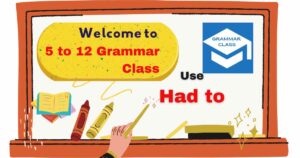In this lesson we will learn how to use had to as an Auxiliary Verb with the verb root (V1).
In negative and interrogative sentences, use the auxiliary verb did and have to instead of had to.
We are also going to use a suitable formula for that so that it will be easy to understand.
The verb uses this construction to show whether or not an action had to be done in the past.
या सदरामध्ये आपण had to चा वापर क्रियापद म्हणून क्रियापदाच्या मुळ रुपासोबत ( V1) कसा करावा याविषयी इत्यंभूत माहिती घेणार आहोत.
नकारार्थी व प्रश्नार्थक वाक्यांमध्ये did हे साह्यकारी क्रियापद व had to ऐवजी have to हे रूप वापरावे.
त्यासाठी योग्य अशा सूत्राचा सुद्धा वापर करणार आहोत म्हणजे समजायला सोपे जाईल.
क्रिया करणाऱ्यास एखादी क्रिया भूतकाळात करावीच लागत होती किंवा नव्हती हे दर्शवण्यासाठी या रचनेचा वापर करतात.
********************************
होकारार्थी वाक्य
How to Use “had to” as a Auxiliary Verb in Affirmative Sentences
Subject + had to + v1.
I had to break.
I had to clean.
I had to compromise.
I had to sing.
I had to learn.
We had to pay.
We had to suggest.
We had to accept.
We had to excuse.
We had to donate.
You have to build.
You have to make.
You had to maintain.
You had to protect.
You had to submit.
They had to provide.
They had to co-operate.
They had to appoint.
Janhavi and Vedant had to dance.
Prashant and Ashwini had to teach.
He had to continue.
He had to enquire.
Vedant had to play.
She had to continue.
Janhavi had to discuss.
She had to combine.
It had to jump.
The dog had to run.
!!!!!!!!!!!!!!!!!!!!!!!!!!!!!!!!!!!!!!!!!!!!!!!!!!!
नकारार्थी वाक्य
How to Use “had to” as a Auxiliary Verb in Negative Sentences
नकारार्थी वाक्यांमध्ये did + not हे साह्यकारी क्रियापद व had to ऐवजी have to हे रूप वापरावे.
Subject + did + not + have to + v1.
did + not = didn’t
I didn’t have to break.
I didn’t have to clean.
I didn’t have to compromise.
I didn’t have to sing.
I didn’t have to learn.
We didn’t have to pay.
We didn’t have to suggest.
We didn’t have to accept.
We didn’t have to excuse.
We didn’t have to donate.
You didn’t have to build.
You didn’t have to make.
You didn’t have to maintain.
You didn’t have to protect.
You didn’t have to submit.
They didn’t have to provide.
They didn’t have to co-operate.
They didn’t have to appoint.
Janhavi and Vedant didn’t have to dance.
Prashant and Ashwini didn’t have to teach.
He didn’t have to continue.
He didn’t have to enquire.
Vedant didn’t have to play.
She didn’t have to continue.
Janhavi didn’t have to discuss.
She didn’t have to combine.
It didn’t have to jump.
The dog didn’t have to run.
********************
प्रश्नार्थक वाक्य
How to Use “had to” as a Auxiliary Verb in Interogative Sentences
प्रश्नार्थक वाक्यांमध्ये did हे साह्यकारी क्रियापद व had to ऐवजी have to हे रूप वापरावे.
Did + subject + have to + v 1?
Didn’t + s + have to + v1?
Did I have to break?
Did I have to clean?
Did I have to compromise?
Didn’t I have to not sing?
Did I have to not learn?
Did we have to pay?
Did we have to suggest?
Did we have to accept?
Didn’t we have to excuse?
Did we have to donate?
Did you have to build?
Did you have to make?
Did you have to maintain?
Didn’t you have to protect?
Didn’t you have to submit?
Did they have to provide?
Didn’t they have to co-operate?
Did they have to appoint?
Did Janhavi and Vedant have to dance?
Didn’t Prashant and Ashwini have to teach?
Did he have to continue?
Did he have to enquire?
Did Vedant have to play?
Didn’t she have to continue?
Didn’t Janhavi have to discuss?
Did she have to combine?
Did it have to jump?
Didn’t the dog have to run?
===============================
We at this blog spot are trying to provide innovative and easy to practice information based on familiar things so that we can further improve the basic knowledge of the English language that we are familiar with.
Also we must remember that English is not knowledge but it is a language, a medium to express knowledge.
आपण या ब्लॉग स्पॉटवर आपल्याला परिचित असणाऱ्या इंग्लिश भाषेच्या पायाभूत माहिती मध्ये आणखी सुधारणा करता यावी म्हणून परिचित गोष्टींवर आधारित नावीन्यपूर्ण व सरावास सुलभ अशी माहिती देण्याचा प्रयत्न करत आहोत.
तसेच आपण हेही लक्षात ठेवले पाहिजे की इंग्रजी म्हणजे ज्ञान नव्हे तर ती एक भाषा आहे, ज्ञान प्रकट करण्याचे एक माध्यम आहे.


